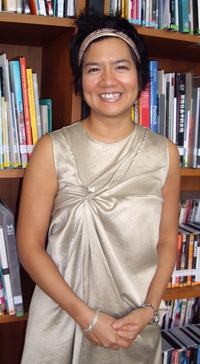The Never Ending Threads – The Journey from the Traditional to the Contemporary Weaving of Thailand
On Thursday, June 19 at 10:30 a.m. Khun Jarupatcha Achavasmit gave a very interesting talk about Thai textiles. The lecture was at the William Warren Library, at the Jim Thompson House in Bangkok, and was organized by The Thai Textile Society. Khun Jarupatcha talked about modern fabric designers who bring new ideas to weaving. Traditional Thai weaving in cotton or silk is already intricate and beautiful. Add fabric dye, or digitally print on the fabric, and weave the threads slightly differently, and the fabric becomes modern art.
Khun Jarupatcha is a fabric designer and teacher. The first designer she talked about is Lady Lea Dingjan-Laarakker. Lady Lea combines fabric dying with weaving. She paints the warp threads, which are attached to the loom before weaving begins. She uses environmentally friendly dyes from Switzerland. Lady Lea has a background in western painting and that brings something new to the Thai silk weaving.
Next Khun Jarupatcha talked about Sasiwan Damrongsiri of Chabatik. She works with ikat weaving, also known as mudmee. She does modern things with the motif such as enlarging the scale of the design from 1 millimeter to 1 inch so the design looks different.
Next the talk included Nussara Tiengkeit who has a boutique in Chiang Mai called “Nussara.” Her idea is to create spaces in the fabric for a new effect, by leaving out some threads during the weaving. The new look is so popular that it has been copied and can be seen wherever tourists buy souvenir textiles and wall hangings, such as at the Emporium.
Other modern designers discussed were: Kachama K. Perez, a fiber artist trained in Japan, Kent Gregory of Sop Moei Arts, and Elisabetta Ziller, a 21 year old student from England, who looks at traditional textiles with the question, “Why does it have to be this way?”
The lecture was in English, but with many Thai university students there, we had some questions and answers in Thai at the end, with translation. One question concerned the fact that the traditional weavers are older people. We don’t see many young people at the looms. Does this mean traditional weaving is on the way out? A good answer came from the audience. A university student (a young man) thought that if we are even asking this question, chances are there is interest and it will not die out.
Another student wondered if the beautiful modern art created by these upcoming designers will catch on around the world but be out of reach for the typical local customer who used to use it in daily life. No one had an answer for that one.
Remember Bangkok Fashion City? Bangkok was supposed to be a fashion hub. It was ended by the government in 2006. Khun Jarupatcha had some beautiful clothing in the fashion shows though! One cute dress had a woven geometric print she called “gridlock,” named after the traffic jams in Bangkok.
Currently, Khun Jarupatcha works as part of a design team at Thailand Carpet Manufacturing. She uses leftover yarn from industrial carpet production and hand weaves it into the “Royal Weave” line of carpets. How did Khun Jarupatcha learn to weave? She went to the village of Bang Rai and lived there for two months as a “girl who wanted to learn how to weave.” It all adds up to a passion for Thai weaving that made for a very interesting lecture.

Reply